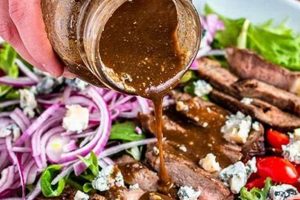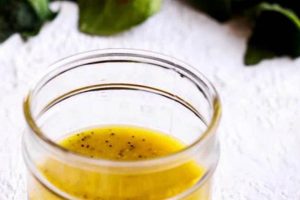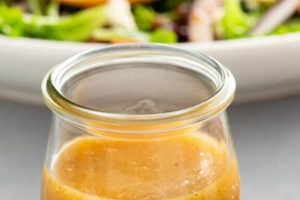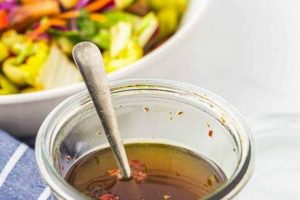Recipes for salad dressings frequently utilize olive oil as a primary ingredient. A simple vinaigrette, for example, combines this oil with an acidic element like vinegar or citrus juice, often seasoned with herbs, spices, or other flavor enhancers. The type of olive oil selected, whether extra virgin, virgin, or light, influences the final flavor profile.
The prevalence of this oil in salad preparation stems from its flavor contribution and potential health benefits. Rich in monounsaturated fats, it aligns with heart-healthy dietary patterns. Furthermore, the oil’s texture provides a desirable mouthfeel, coating ingredients and enhancing their individual flavors. Historically, olive oil’s culinary use dates back millennia, particularly in Mediterranean cuisines where it continues to be a staple.
This exploration will delve further into various recipes utilizing this versatile oil, ranging from classic vinaigrettes to creamy emulsions, highlighting diverse flavor combinations and techniques suitable for both novice and experienced cooks.
Tips for Crafting Exceptional Olive Oil-Based Salad Dressings
Achieving a well-balanced and flavorful salad dressing requires attention to detail and an understanding of fundamental principles. The following tips offer guidance for creating dressings that enhance, rather than mask, the flavors of fresh ingredients.
Tip 1: Emulsification Techniques: Proper emulsification creates a stable and homogenous dressing. Whisking the oil slowly into the acidic element while maintaining continuous agitation ensures a cohesive blend that won’t separate.
Tip 2: Quality Ingredients: The quality of the olive oil significantly impacts the final result. Extra virgin olive oil offers robust flavor, while lighter varieties provide a more neutral base. Freshly squeezed citrus juice and high-quality vinegar contribute brightness.
Tip 3: Balancing Flavors: A harmonious balance of acidity, sweetness, and saltiness is essential. Taste and adjust seasoning as needed, considering the inherent flavors of the salad ingredients.
Tip 4: Seasoning Exploration: Experiment with a variety of herbs, spices, and aromatics. Freshly chopped herbs, minced garlic, or a pinch of red pepper flakes can add complexity and depth.
Tip 5: Proper Storage: Store homemade dressings in airtight containers in the refrigerator. Emulsified dressings typically last longer than those with separated ingredients.
Tip 6: Oil to Acid Ratio: A standard vinaigrette ratio is 3 parts oil to 1 part acid. However, this can be adjusted based on personal preference and the specific ingredients used.
Tip 7: Infusion Techniques: Infusing olive oil with herbs or spices before incorporating it into the dressing can add unique flavor dimensions. Gentle heating enhances the infusion process.
By employing these techniques, one can consistently produce delicious and healthful olive oil-based salad dressings that elevate any salad.
These insights provide a foundation for creating flavorful dressings. The following sections will explore specific recipe examples and variations.
1. High-quality olive oil
High-quality olive oil plays a crucial role in crafting exceptional salad dressings. The nuanced flavors and aromas of extra virgin olive oil, in particular, significantly influence the final taste profile. Its fruity, peppery notes can elevate a simple vinaigrette, while its smooth texture contributes to a pleasant mouthfeel. A dressing made with low-quality oil, conversely, may exhibit undesirable flavors or a greasy consistency, detracting from the overall sensory experience. For example, a delicate spring mix salad dressed with a high-quality extra virgin olive oil infused with fresh herbs creates a vibrant and harmonious dish, whereas using a lower-grade oil could mask the subtle flavors of the greens.
The chemical composition of high-quality olive oil also contributes to its efficacy in salad dressings. Rich in monounsaturated fats and antioxidants, it offers potential health benefits. Furthermore, its ability to emulsify with acidic ingredients like vinegar or citrus juice creates a stable and cohesive dressing. This stability prevents separation and ensures even distribution of flavor across the salad. Consider a classic balsamic vinaigrette: the high-quality olive oil emulsifies with the balsamic vinegar, creating a smooth and creamy texture that clings lightly to the salad ingredients. A lower-quality oil might resist emulsification, resulting in a watery and less appealing dressing.
Selecting high-quality olive oil represents a fundamental step in creating superior salad dressings. Its flavor profile, chemical properties, and ability to emulsify contribute significantly to the overall quality and sensory experience. Understanding these factors allows for informed decisions when crafting dressings, ensuring a delightful culinary outcome. Investing in superior olive oil ultimately enhances the flavor, texture, and nutritional value of the final dish. This attention to detail elevates a simple salad into a truly satisfying culinary experience.
2. Balanced Acidity
Balanced acidity is a cornerstone of successful olive oil-based salad dressings. The interplay between the richness of the oil and a carefully calibrated acidic component defines the dressing’s overall character and its ability to complement the other salad ingredients. Without sufficient acidity, the dressing can taste flat and overly rich. Excessive acidity, conversely, can overwhelm the other flavors and create an unpleasant sharpness.
- The Role of Acid
Acidic ingredients, such as vinegar or citrus juice, serve multiple purposes in salad dressings. They provide a counterpoint to the oil’s richness, brightening the flavor profile and adding a refreshing tang. Acidity also contributes to the preservation of the dressing, inhibiting bacterial growth. Furthermore, acid helps to tenderize certain vegetables and enhance their flavors.
- Types of Acidic Ingredients
A wide array of acidic ingredients can be incorporated into olive oil-based dressings. Common choices include various vinegars (balsamic, red wine, apple cider), citrus juices (lemon, lime, orange), and even yogurt or buttermilk. Each option imparts its own unique flavor profile and level of acidity, influencing the dressing’s final character. For instance, balsamic vinegar lends a sweet and tangy complexity, while lemon juice adds a bright, citrusy note.
- Achieving Balance
The ideal balance of acidity depends on several factors, including the type of olive oil used, the other ingredients in the dressing, and the flavors of the salad itself. A general guideline is a ratio of three parts oil to one part acid, but this can be adjusted to personal preference. Tasting and adjusting the dressing throughout the preparation process is crucial to achieving optimal balance.
- Impact on Flavor and Texture
Acidity not only influences the flavor of the dressing but also its texture. It plays a key role in the emulsification process, helping to bind the oil and aqueous ingredients together. Proper emulsification creates a smooth, creamy texture that coats the salad ingredients evenly. Without sufficient acidity, the emulsion may break down, resulting in a separated and less appealing dressing.
The careful consideration of acidity is essential in crafting exceptional olive oil-based salad dressings. By understanding the role of acid, exploring the variety of acidic ingredients available, and mastering the art of balance, one can create dressings that elevate the flavor and texture of any salad. A well-balanced acidity ensures a harmonious blend of flavors, enhancing the overall culinary experience.
3. Fresh Ingredients
Fresh ingredients are paramount in crafting exceptional olive oil-based salad dressings. The quality and vibrancy of these components directly impact the final flavor profile, creating a noticeable difference between a truly exceptional dressing and a mediocre one. Freshness enhances the delicate interplay between the olive oil, acidic elements, and other seasonings, resulting in a brighter, more nuanced taste experience. Utilizing fresh ingredients maximizes the potential of a salad dressing recipe, transforming simple components into a harmonious culinary creation.
- Herbs
Fresh herbs provide a crucial aromatic and flavor dimension to olive oil-based dressings. Unlike dried herbs, which can taste dull and muted, fresh herbs offer a burst of vibrant flavor. Chiffonade of basil adds a sweet, peppery note to a simple vinaigrette, while chopped parsley contributes an earthy, slightly bitter counterpoint. The choice of herbs should complement the other salad ingredients and the overall flavor profile of the dressing. Incorporating fresh herbs elevates a basic olive oil and vinegar dressing, transforming it into a nuanced culinary delight.
- Citrus Fruits
Freshly squeezed citrus juice, as opposed to bottled varieties, offers unparalleled brightness and complexity to salad dressings. The essential oils present in the zest add an aromatic depth, while the juice provides the necessary acidity to balance the richness of the olive oil. A lemon vinaigrette, for example, gains a vibrant tang from freshly squeezed lemon juice, whereas bottled lemon juice might taste flat and lackluster. The use of fresh citrus ensures that the dressing contributes a refreshing zing to the salad, enhancing the overall taste experience.
- Garlic and Onions
Fresh garlic and onions introduce pungent and savory notes to olive oil-based dressings. Minced fresh garlic provides a sharp, assertive flavor, while finely diced shallots offer a milder, sweeter alternative. Roasting garlic mellows its intensity, creating a deep, caramelized flavor that adds complexity to the dressing. Utilizing fresh alliums allows for nuanced flavor combinations, enhancing the depth and complexity of the final product. These ingredients, when fresh, contribute significantly to the overall balance and savory character of the dressing.
- Spices
Freshly ground spices offer a more potent and nuanced flavor compared to pre-ground options. Freshly cracked black pepper adds a sharp bite, while freshly grated nutmeg imparts a warm, slightly sweet aroma. The volatile oils in freshly ground spices dissipate quickly, so incorporating them just before serving preserves their intensity. This practice ensures that the spices contribute their full flavor potential, enhancing the complexity and overall enjoyment of the salad dressing.
The emphasis on fresh ingredients elevates olive oil-based salad dressings from simple condiments to complex flavor enhancers. The vibrant flavors and aromas of fresh herbs, citrus, alliums, and spices contribute significantly to the overall sensory experience. By prioritizing freshness, one unlocks the full potential of these simple ingredients, creating dressings that complement and enhance the flavors of any salad. The choice to use fresh ingredients represents a commitment to quality and a deeper understanding of the delicate balance of flavors that define exceptional cuisine.
4. Proper Emulsification
Proper emulsification is crucial for creating successful olive oil-based salad dressings. It determines the texture, stability, and overall sensory experience of the dressing. A well-emulsified dressing exhibits a smooth, creamy consistency and resists separation, ensuring that the flavors are evenly distributed throughout the salad. Conversely, a poorly emulsified dressing appears watery, separates quickly, and delivers an uneven distribution of flavors.
- The Science of Emulsification
Emulsification is the process of combining two immiscible liquids, such as oil and water, into a stable mixture. In salad dressings, olive oil represents the oil phase, while vinegar or citrus juice constitutes the water phase. These two phases naturally repel each other, requiring an emulsifying agent to bind them together. The emulsifier contains both hydrophobic and hydrophilic components, allowing it to interact with both the oil and water, creating a stable emulsion.
- Emulsifying Agents in Salad Dressings
Several ingredients act as emulsifiers in olive oil-based salad dressings. Mustard, egg yolks, and honey are common choices. Mustard contains lecithin, a natural emulsifier. Egg yolks contain proteins and lecithin, both contributing to emulsification. Honey’s viscous texture and natural sugars assist in stabilizing the emulsion. The choice of emulsifying agent influences the flavor and texture of the final dressing.
- Techniques for Achieving Proper Emulsification
Achieving proper emulsification requires specific techniques. The most common method involves slowly whisking the oil into the vinegar or citrus juice while maintaining continuous agitation. This gradual incorporation allows the emulsifier to effectively coat the oil droplets, preventing them from coalescing and separating. Another technique involves using a blender or food processor, which creates a more forceful emulsification process, ideal for thicker dressings.
- Factors Affecting Emulsification
Several factors can affect the stability of an emulsion. Temperature plays a significant role; extreme temperatures can cause the emulsion to break down. The ratio of oil to acid also influences stability; a proper balance is essential. The presence of salt can improve emulsification, while excessive salt can have the opposite effect. Understanding these factors allows for greater control over the emulsification process.
Proper emulsification is essential for creating high-quality olive oil-based salad dressings. It influences the texture, stability, and flavor distribution of the dressing. By understanding the science of emulsification, selecting appropriate emulsifying agents, employing correct techniques, and considering the factors that influence stability, one can consistently produce dressings that enhance the overall culinary experience. A well-emulsified dressing complements the flavors of the salad, creating a harmonious and satisfying dish.
5. Complementary Seasonings
Complementary seasonings play a pivotal role in elevating olive oil-based salad dressings from simple mixtures to complex flavor experiences. The careful selection and balance of seasonings enhance the inherent qualities of the olive oil and other dressing components, creating a symphony of flavors that complement the salad ingredients. This nuanced approach transforms a basic vinaigrette into a culinary highlight, adding depth and character to the overall dish.
The interaction between seasonings and olive oil involves a delicate interplay of flavors and aromas. The peppery, fruity notes of high-quality extra virgin olive oil provide a foundation upon which other seasonings can build. For example, a Mediterranean-inspired dressing might incorporate oregano, thyme, and garlic, their earthy, herbaceous notes harmonizing with the olive oil’s richness. A brighter, more citrus-forward dressing could benefit from the addition of fresh dill, mint, or chives, their lighter, more delicate flavors complementing the citrus and olive oil. The specific seasonings chosen should consider the type of olive oil used, the other dressing ingredients, and the overall flavor profile of the salad itself.
Practical application of this understanding involves careful consideration of flavor pairings. A salad featuring robust ingredients like grilled vegetables or roasted meats might benefit from a dressing seasoned with bolder spices like cumin, coriander, or smoked paprika. Conversely, a salad composed of delicate greens and fresh fruits might be best served by a dressing seasoned with lighter herbs and spices, such as basil, tarragon, or a touch of lemon zest. Understanding these nuances allows for the creation of dressings that not only complement the salad but also enhance the overall dining experience. The strategic use of complementary seasonings transforms a simple salad into a sophisticated culinary creation, demonstrating a mastery of flavor balance and ingredient synergy.
6. Appropriate Storage
Appropriate storage is essential for maintaining the quality and extending the shelf life of olive oil-based salad dressings. Exposure to light, heat, and air can degrade the oil, causing it to become rancid and develop off-flavors. Furthermore, improper storage can compromise the stability of the emulsion, leading to separation and a less desirable texture. Storing dressings correctly preserves their flavor, texture, and overall quality, ensuring a consistently enjoyable culinary experience.
Practical storage guidelines dictate that olive oil-based salad dressings should be kept in airtight containers in a cool, dark place. Refrigeration is generally recommended, particularly for dressings containing fresh ingredients like herbs or citrus juice. Refrigeration slows down the oxidation process and inhibits bacterial growth, prolonging the dressing’s shelf life. For example, a freshly made vinaigrette stored in a sealed container in the refrigerator can typically last for several days to a week, whereas the same dressing left at room temperature might spoil within a day or two. Proper storage also helps to maintain the emulsion’s stability. Temperature fluctuations can cause the oil and aqueous phases to separate, so consistent refrigeration is essential for preserving the desired creamy texture.
Understanding the impact of storage on olive oil-based salad dressings allows for better preservation of their quality and flavor. By adhering to proper storage practices, such as using airtight containers and refrigerating dressings, one can minimize oxidative damage, prevent bacterial growth, and maintain emulsion stability. This conscientious approach ensures that the dressing remains fresh and flavorful, enhancing the overall enjoyment of the salad. Appropriate storage is a crucial step in maximizing the shelf life and preserving the sensory qualities of these culinary creations, reflecting a commitment to quality and culinary excellence.
7. Creative Flavor Combinations
Creative flavor combinations represent a significant avenue for culinary exploration within the realm of olive oil-based salad dressings. The inherent versatility of olive oil allows it to serve as a canvas for a diverse range of flavor profiles, extending far beyond basic vinaigrettes. Understanding the interplay between different ingredients unlocks the potential for crafting unique and exciting dressings that elevate the simplest of salads.
The foundational elements of a salad dressingolive oil, acid, and seasoningsoffer a starting point for creative exploration. Consider the interplay between different types of olive oil: a robust extra virgin olive oil provides a peppery backdrop, while a milder olive oil offers a more neutral base. Acidity can be derived from a variety of sources, each contributing unique characteristics. A bright lemon vinaigrette gains complexity with the addition of fresh herbs like dill and mint, while a balsamic vinaigrette transforms with the incorporation of Dijon mustard and honey. Flavor combinations extend beyond traditional pairings; consider the unexpected harmony of roasted garlic and orange zest in a vinaigrette, or the intriguing combination of smoked paprika and maple syrup in a dressing for a hearty autumn salad. Such creativity allows for personalized flavor profiles tailored to individual preferences and specific salad components.
Practical applications of this creative approach are boundless. Ethnic cuisines offer a wealth of inspiration: a Thai-inspired dressing might incorporate lime juice, fish sauce, ginger, and chili flakes, while a Middle Eastern-inspired dressing could feature tahini, sumac, and lemon. Seasonal ingredients also provide opportunities for creativity: a spring salad might benefit from a light and herbaceous dressing with chives and lemon, while a winter salad could be enhanced by a richer dressing with roasted butternut squash and maple syrup. Mastering the art of flavor combination elevates salad preparation from a simple task to an engaging culinary pursuit. It allows for continuous experimentation and the discovery of exciting new taste experiences, enriching the culinary landscape and demonstrating the transformative potential of creative flavor combinations within the context of olive oil-based salad dressings.
Frequently Asked Questions about Olive Oil-Based Salad Dressings
This section addresses common inquiries regarding the preparation and utilization of olive oil-based salad dressings.
Question 1: What is the ideal ratio of olive oil to acid in a basic vinaigrette?
A standard vinaigrette typically employs a 3:1 ratio of olive oil to acid. However, this ratio can be adjusted based on personal preference and the specific ingredients used. A milder vinegar might require a lower ratio, while a more assertive vinegar might allow for a higher ratio.
Question 2: How can one prevent olive oil-based dressings from separating?
Proper emulsification is key to preventing separation. Slowly whisking the oil into the acid while maintaining continuous agitation creates a stable emulsion. Utilizing an emulsifying agent, such as Dijon mustard or honey, further enhances stability.
Question 3: What is the best type of olive oil to use in salad dressings?
Extra virgin olive oil, with its robust flavor and aroma, is generally preferred for salad dressings. However, lighter olive oils can be used for those seeking a more neutral flavor profile.
Question 4: How long can homemade olive oil-based dressings be stored?
Homemade dressings stored in airtight containers in the refrigerator typically last for one to two weeks. Dressings containing fresh ingredients like herbs or garlic may have a shorter shelf life.
Question 5: Can olive oil-based dressings be used for more than just salads?
Absolutely. Olive oil-based dressings can serve as marinades for meat, poultry, or vegetables. They can also be used as dipping sauces or drizzled over roasted vegetables or grilled fish.
Question 6: How can one adjust the flavor of an olive oil-based dressing?
Flavor adjustments can be achieved by adding various seasonings. Fresh or dried herbs, spices, garlic, shallots, or a touch of sweetness from honey or maple syrup can enhance the complexity of the dressing.
Understanding these fundamental aspects of olive oil-based salad dressings allows for greater control over the final product. Experimentation and attention to detail are encouraged to discover flavor profiles that best suit individual palates.
The following section will explore specific recipe examples, showcasing the versatility and potential of olive oil-based salad dressings.
Conclusion
This exploration of olive oil-based salad dressing recipes has highlighted the crucial role of ingredient quality, balanced acidity, proper emulsification, complementary seasonings, and appropriate storage in achieving optimal flavor and texture. The versatility of olive oil allows for a wide range of flavor profiles, from classic vinaigrettes to more complex creations incorporating diverse herbs, spices, and other ingredients. An understanding of these fundamental principles empowers culinary experimentation and the development of dressings tailored to individual preferences.
The potential of olive oil extends beyond basic salad enhancement. Its inherent health benefits, combined with its ability to harmonize with a diverse range of flavors, position it as a valuable culinary asset. Continued exploration of flavor combinations and innovative techniques promises further development within the realm of olive oil-based salad dressings, enriching culinary experiences and promoting healthful eating practices.






